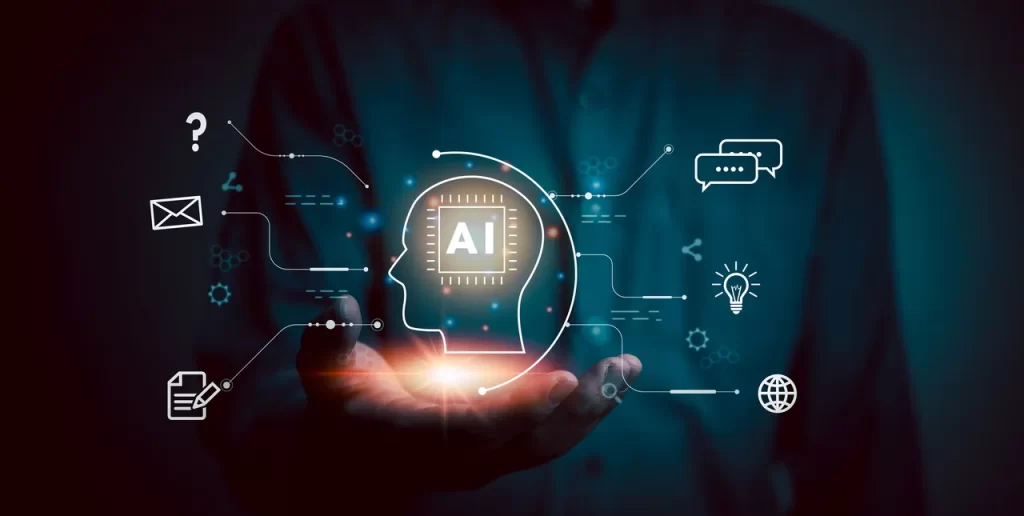In the ever-evolving world of marketing, the integration of artificial intelligence offers a new dawn of possibilities. AI is no longer just a buzzword but a game-changer, turning the wheels of transformation with its potential to redefine the marketing landscape. Whether unveiling hidden insights, fine-tuning customer targeting, predicting future trends, or automating content creation, AI is shaping marketing’s future.
But how can we use this powerful tool ethically, maximize the potential of client information, and create personalized experiences that respect privacy? Let’s explore the world of AI-driven marketing and its undiscovered potential.
A Fresh Chapter in Marketing
Artificial intelligence is surfacing as a game-changer with the potential to redefine marketing. Though still in its infancy, AI and machine learning have shown remarkable ability to glean insights, automate tasks, and create measurable results in the marketing realm.
Top-tier brands are starting to utilize these innovative capabilities to enhance customer understanding, fine-tune targeting, amplify personalization, and streamline resource distribution. As AI integration is still in its early stages, the urgency to leverage AI’s potential is increasing due to competitive demands. Organizations that adopt AI augmentation now can gain an edge over competitors through improved decision-making, anticipatory planning, and rapid growth.

However, despite its potential, AI is not a cure-all. Considerate adoption and ethical application are key to tackling real challenges from data quality to model comprehensibility. By adopting an informed, strategic approach, marketing leaders can responsibly trigger AI-driven innovation while fostering trust with customers and stakeholders. The chance is here to use these tools for competitive distinction and value generation.
I aimed for an enlightening yet approachable introduction without exaggeration. Please let me know if you would like me to adjust or elaborate on the section further. I can provide additional sections focused on data utilization, personalization, forecasting, and more based on the outline. Just give me the signal!
Get more AI + Marketing news
The Dawn of a New Era in Marketing
Artificial intelligence (AI) has subtly made its way into marketing, introducing data-driven insights and automation to tasks that once demanded significant human effort. Top-tier companies are now employing AI for a range of tasks, from predicting customer lifetime value to creating targeted ad copy. While some may label this as the next big thing in marketing, it’s important to look past the hype. AI-powered marketing does offer real opportunities for brands, but it calls for careful and thoughtful implementation.
The transition towards AI marketing has been a steady progression over the past decade. With the exponential increase in processing power, the abundance and affordability of data storage, and the sophistication of algorithms, a new era of AI applications was born. Marketers quickly saw the potential of AI for extracting insights from data and leveraged it to build predictive models. From dynamic pricing to personalized product recommendations, the possibilities seemed limitless.

Today, AI is becoming a necessity in marketing. Take sales forecasting for example. Where businesses once depended solely on analysts scrutinizing spreadsheets, machine learning algorithms can now predict revenue more accurately by identifying subtle patterns in data. Content creation, traditionally a manual and time-consuming process, is another area experiencing automation. AI tools can generate vast amounts of written content, videos, and even images. While the output may not always be perfect, it provides a solid base for people to refine.

Does this signify the arrival of an era of automated marketing devoid of human creativity? Not quite. Most current AI marketing tools are specialized. They excel at specific tasks like prediction but falter when faced with the ambiguity inherent in creative work. AI is not yet capable of replacing human judgment, strategy, and innovation. Instead, the ideal role for AI is to enhance and empower marketers to work more efficiently and quickly.
Brands at the forefront of AI marketing generally adopt a balanced approach. They begin by identifying bottlenecks and investigating where algorithms can ease friction. Most concentrate AI on repetitive tasks like data processing and use automation to free up employees’ time. This collaboration between humans and machines allows people to devote more time to strategic planning and innovation. For now, keeping the human in the loop yields the best results.
So, while AI marketing may not be revolutionary in the radical sense, it does offer real opportunities for gains in efficiency and intelligence. The brands that can thoughtfully implement the right AI tools for their needs will outpace the competition. But rather than rushing to adopt AI for the sake of it, marketers should carefully evaluate how algorithms can address specific challenges. With the right framework, AI can elevate marketing to new heights. But it requires a discerning hand to ensure technology supports strategy rather than dictating it.
Maximizing the Potential of Client Information
Client information is the vital force behind effective AI-driven marketing. Machine learning algorithms depend on high-quality data to reveal insights that enhance relevance. By consolidating data sources and ensuring precision, brands prepare their AI tools for triumph.
Amalgamating data from various channels offers a holistic view of each client. This powers intricate behavioral analysis and predictive modeling. As AI identifies trends and patterns within unified data platforms, marketers gain insight for precise targeting and personalization.
Extracting value from AI necessitates an investment in data health. Keeping an eye out for errors, inconsistencies, and gaps is beneficial. Enriching first-party data with trustworthy third-party sources is equally important. With high-quality data powering AI systems, hidden possibilities come to light.
Brands often hold more data than they are aware of. AI enables the utilization of underused data stuck in silos. As algorithms sift through datasets, they reveal surprising trends and segments ready for customized messaging. Marketers who are open to experimenting with data sources can creatively extract more meaningful information from the clutter.
The data management effort required for AI marketing should not be downplayed. However, once brands establish a robust data foundation, AI provides a profound understanding of consumers. Data provides context and humanizes personas for pertinent brand interactions. AI-driven analytics transform static data into strategic opportunities.
Getting Personal with Individualized Experiences

AI and big data are our allies in understanding each customer as a unique individual. Through the analysis of behavioral data and purchase history, we can create detailed customer profiles using marketing technology. This knowledge enables us to engage people with messages and offers that align with their preferences.
However, personalization should not cross the line into invasion of privacy. It’s crucial to respect privacy boundaries. Data collection and profiling should focus on behavior rather than personal details. The aim is to provide relevant customization that adds value, not to engage in overly-familiar or unsettling targeting.
Strategies for one-to-one personalization include:
– Dynamic content that evolves based on the individual’s profile and past site behavior, such as showcasing products the customer has shown interest in.
– Personalized product or content suggestions based on purchase history data, not assumptions. For instance, if someone buys hiking gear, recommend local trails, not unrelated items.
– Customized email content with relevant offers and information that align with each subscriber’s interests.
– Tailored web experiences driven by intelligence about the individual’s needs and context, like only showing chat bot options that apply to that customer.
– Retargeting ads that align with recent site browsing rather than generic blasts.
While the technology for personalization is advancing at a rapid pace, the human touch remains vital. The optimal approach combines AI capabilities with marketing creativity and empathy. We can use personalization to delight customers without being overly familiar or intrusive, delivering the right message at the right time to the right person.
Peeking into the Future: The Magic of AI-Driven Predictive Analytics
Thriving in business often hinges on your ability to anticipate subtle changes before your rivals do. New technologies can pave the way for groundbreaking growth opportunities, while evolving consumer behaviors can transform markets in the blink of an eye. In our ever-changing world, the future favors brands that can peek into what’s coming next.

Enter the world of powerful predictive analytics, your marketing strategy’s own magic crystal ball. Machine learning algorithms sift through data to highlight budding trends. These models analyze past behaviors, economic indicators, industry reports, and more to predict what lies ahead. As more data flows in, these algorithms become even more intelligent.
Think of predictive analytics as your early warning system. It identifies increasing queries and engagement surges around new products. It brings to light potential inventory shortages or service bottlenecks as demand fluctuates. You’ll even identify emerging customer segments to focus on.
The real charm is in the ability to plan ahead. You’ll be able to adjust budgets, reposition campaigns, and revamp creatives to seize upcoming opportunities. Proactive brands shift resources to ride new trends while competitors scramble to keep up.
Effective execution blends human creativity with machine intelligence. Predictive analytics steers your strategy and content frameworks. Then, human marketers step in to weave compelling narratives and experiences. It takes a blend of the best of both worlds to truly tap into the predictive prowess of AI.
While the future remains a mystery, brands now have tools to spot key trends on the horizon. Sharpen your foresight with predictive analytics steering your marketing strategy. You’ll deliver more relevant customer experiences while staying steps ahead of market fluctuations. When it comes to peeking into the future, foresight gives you an unbeatable advantage.
Playing with AI in Content Creation
Artificial intelligence (AI) is not here to steal the show in content creation, but to enhance human creativity. AI tools are designed to handle the mundane and repetitive tasks, freeing writers and marketers to concentrate on strategic, high-value work.
Techniques such as Natural Language Generation (NLG) can turn raw data into narratives that are easily understood by humans. Additionally, optimization algorithms can test different content variations, refining the message based on performance data.
However, content solely generated by machines often misses the human touch, the emotional resonance that drives action. The most effective strategy is to use AI as a partner, allowing NLG to create initial content drafts, which are then refined by a human editor.

This approach speeds up content ideation and production without sacrificing quality or brand voice. It’s a chance to expand content operations and free up creative energy.
Platforms like WordAI and Jasper.ai are perfect examples of this blend of automated drafting and manual oversight. Marketers provide the AI system with core data, messaging, and guidelines, and the system produces unique content variations.
Human reviewers then select the best drafts, adjust the message for brand suitability, and publish polished content on a large scale. This semi-automated method combines the strengths of both humans and machines.
As AI technology continues to evolve, it’s set to become an invaluable tool for marketers to enhance content ideation, personalization, and distribution. The secret is to use AI tools as partners, not as complete replacements.
By integrating automation and human creativity effectively, brands can reach new heights in marketing productivity and performance.
Embracing AI in marketing is about striking the perfect balance—leveraging automation for efficiency while preserving human creativity for strategy and empathy. With thoughtful adoption, AI can be a powerful ally, enhancing personalization, predictive analytics, and content creation for competitive advantage and unprecedented marketing success.




Permalink
Permalink
Permalink